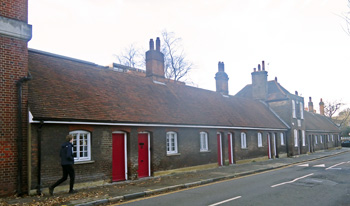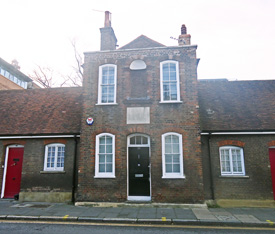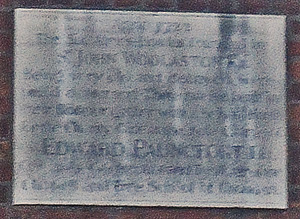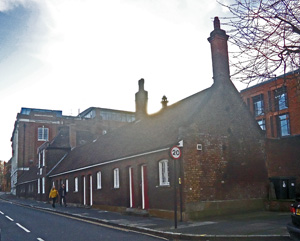|
Wollaston's and Pauncefort's Almshouses 15-37 Southwood Lane, Highgate, N6 5ED
|
During his lifetime Sir John Wollaston (1590-1658), a goldsmith and former Lord Mayor of London, built a terrace of almshouses for six poor men and women of good character, who were inhabitants of Hornsey and Highgate.
In his will, dated 15th April 1658, he appointed the Governors of the Free School of Highgate and their successors as trustees; they were also charged with appointing the inhabitants of the almshouses. Sir John endowed the almshouses, so that the almspeople would receive an income of 50 shillings (£2.50) a year, paid quarterly on the four usual quarter days, and money could be set aside for repairs to the building.
Regulations for the almshouses were drawn up by the School around 1669: all almspeople had to attend service in the School's chapel, married couples were not accommodated and no inmate was permitted to marry.
Although men were eligible for admission, most of the residents were women. Selection took place at the meetings of the School Governors.
By the beginning of thr 18th century the building had become dilapidated. In 1722 it was demolished and the almshouses were rebuilt by Edward Pauncefort, one of the Governors and the Treasurer of the Chapel and Free School. He doubled the number of almhouse dwellings to 12 and - in the centre of the terrace - added a school house for charity girls, with accommodation for the mistress. In his will dated 1723 Pauncefort provided an income of £30 a year for the almspeople. Thus, they received pensions from the distinct Wollaston and Pauncefort charities and, by 1797, were all being paid an annual stipend of £7, including from various other bequests.
By 1827 most of the inmates were the widows of tradesmen, aged 50 years or above.
Although Wollaston had intended that Hornsey residents would be eligible for admission to the almshouses, by 1869 the charity was used exclusively by those living in Highgate.
By the second half of the 19th century the charity school had closed and the schoolhouse was let out as a residence.
In 1951 the almshouses were Grade II listed.
In 1961 repairs and improvements were carried out to the buildings. Because the almswomen received Old-Age Pensions and other benefits, the trustees reduced the stipend paid out to them. They also ceased their contributions towards fuel and put the savings towards the electricity bill.
The almshouses were finally modernised in 1988. Until then, they had had only outdoor sanitation and each dwelling had a single tap. The 12 almshouses were converted into six single-bedroom apartments.
Current status
The almshouses are now managed by Pathways on behalf of the Wollaston and Pauncefort Almshouses Charity.New residents to the sheltered housing scheme are accepted from 60 years of age.
N.B. Photographs obtained in November 2020

The terrace of almshouses was beside the Free School on the west side of Southwood Lane. The School's Chapel was on the opposite side of the road.

The Pauncefort Charity School for Girls occupied the 2-storey central building.

A stone tablet above the front door states: Anno 1772. The six Almes-Houses founded by Sr. JOHN WOOLASTON Knt. Being very old and decayed were pull'd down: and These twelve built in their Room, together with a School House for the Charity Girls at the Sole Charge of EDWARD PAUNCFORT Esq. One of the Governors and Treasurer of the Chapell and Free School of HIGHGATE.
Modern spelling has rendered the names of the
founders to be spelt as Wollaston and Pauncefort, but both versions
exist in various sources.

One set of almshouses beside the central schoolhouse was attributed to Sir John Wollaston and the other to Edward Pauncefort.
References (Accessed 29th August 2021)
(Author unstated) 1819 Second Report of the Commissioners. London, House of Lords, Parliament.
Lloyd JH 1888 The History, Topography, and Antiquities of Highgate, in the County of Middlesex. London, Highgate Library Fund.
https://edithsstreets.blogspot.com
https://brtishlistedbuildings.co.uk
https://discovery.nationalarchives.gov.uk
https://forebears.io
https://historicengland.org.uk
https://simplebooklet.com
www.blueplaques.net
www.british-history.ac.uk (1)
www.british-history.ac.uk (2)
www.britishmuseum.org
www.flickr.com (1)
www.flickr.com (2)
www.genuki.org.uk
www.london-footprints.co.uk
www.londonpicturearchive.org.uk (1)
www.londonpicturearchive.org.uk (2)
www.londonpicturearchive.org.uk (3)
www.londonpicturearchive.otg.uk (4)
www.londonremembers.com
www.parishmouse.co.uk
www.watercolourworld.org
Last updated 29th August 2021
Click here to return to Almshouses of London alphabetical list
Click here to return to home page